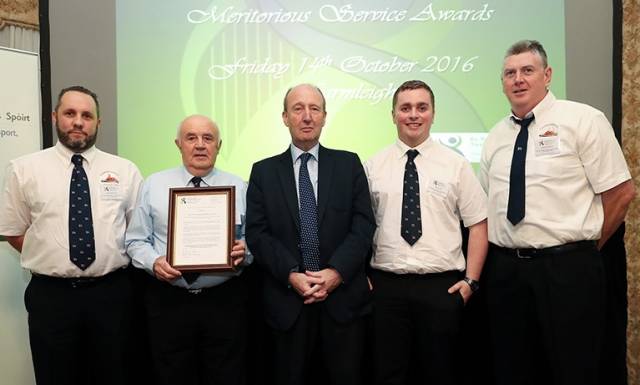The volunteer lifeboat crew from Castletownbere RNLI has been awarded a Marine Ministerial Letter of Appreciation for Meritorious Service.
The award in recognition of the crew’s ability to locate and save a life in challenging weather conditions was presented by the Minister for Transport, Tourism & Sport Shane Ross, T.D. at the National Marine Gallantry and Meritorious Service Awards 2016 at a ceremony in Farmleigh House in the Phoenix Park on Friday evening (14 October).
Castletownbere RNLI was represented at the awards by Lifeboat Operations Manager Tony O’Sullivan, Coxswain Brian O’Driscoll and crew members John Paul Downey and Kyle Cronin.
The call out for which the lifeboat was awarded happened when the Castletownbere lifeboat, Annette Hutton, was launched early on Saturday morning 20 August. After 12 hours at sea in storm force conditions, the volunteer lifeboat crew rescued a lone sailor.
Valentia Coast Guard Radio had requested assistance to a yacht in difficulties 45 miles south of Mizen head in West Cork. The resceu was reported at the time by Afloat.ie here.
The eight-metre yacht, with one person on board, had left the Azores in early August and ran into difficulties the day previous. The sailor, in his sixties, had been in regular radio contact with Valentia Coast Guard radio until the morning when his VHF radio was washed overboard. He activated an EPIRB to identify his location, raise the alarm and seek help.
The lifeboat, under the command of Coxswain Brian O’Driscoll, was launched at 8am and located the casualty at 10.40am 50 miles south-west of Castletownbere. The Irish Coast Guard helicopter was also on scene.
Conditions were described as gusting Force 8/9 winds with a 30 foot swell. The yacht was taken under tow and the lifeboat proceeded slowly to Castletownbere in challenging sea conditions. Early into the tow lifeboat crew became concerned about the wellbeing of the sailor and crew managed to transfer him to the lifeboat. The lifeboat, with the damaged yacht in tow, returned to Castletownbere at 8.30pm having been at sea for 12 and a half hours.
Later that evening the sailor thanked the Castletownbere lifeboat and all involved for ‘saving his life’. He said: ‘only for the lifeboat, things would have ended up very badly today’.
The Castletownbere Coxswain and crew demonstrated skill, seamanship and endurance during what was a long and challenging day.
Speaking at the awards ceremony, Minister Ross praised the ‘courageous achievements and service of this group of brave Irish men and women who have faced crises and dug deep, offering their skills and in many cases placing themselves in danger in order that others might be safe on our waterways’.
Pausing to remember those who lost their lives at sea since the last set of Awards in 2014, Minister Ross spoke of the tragic death of volunteer Coast Guard Caitríona Lucas last month, describing her as ‘a courageous and heroic woman who made the ultimate sacrifice while in the service of others’.
The awards are to recognise outstanding acts of courage, heroism, skill and initiative in the context of marine emergency incidents. The scheme also recognises exceptional dedication to duty in the execution of Ireland’s marine emergency response.
A Marine Ministerial Letter of Appreciation may be awarded for meritorious service where outstanding dedication to duty over a career of service can be demonstrated, or for an act of particular meritorious dedication, showing skill and initiative, but which is not of an order for receipt of a Meritorious Service or Marine Gallantry medal.
The volunteer lifeboat crew from Kinsale RNLI and Lough Swilly RNLI in County Donegal were also awarded a Marine Ministerial Letter of Appreciation.
The National Marine Gallantry and Meritorious Service Awards Committee is chaired by Bryan Dobson of RTÉ.































































